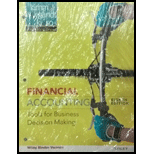
(a)
Earnings per share (EPS): The amount of net income available to each shareholder per common share outstanding is referred to as earnings per share (EPS).
Formula of EPS:
To compute: (a) EPS.
(a)
Explanation of Solution
Compute EPS of Corporation D for 2017, if net income is $70,000, preferred dividends are $0, and weighted common shares outstanding are 33,000 shares.
Compute EPS of Corporation D for 2016, if net income is $60,000, preferred dividends are $0, and weighted common shares outstanding are 30,000 shares.
(b)
Formula of working capital:
To compute: (b) Working capital.
(b)
Explanation of Solution
Compute working capital of Corporation D for 2017.
Compute working capital of Corporation D for 2016.
(c)
Formula of current ratio:
To compute: (c) Current ratio.
(c)
Explanation of Solution
Compute current ratio of Corporation D for 2017.
Compute current ratio of Corporation D for 2016.
(d)
Debt to assets ratio: This financial ratio evaluates the ability of a company to pay off long-term debt obligations owed to creditors. This ratio assesses the solvency of a company.
Formula of debt to assets ratio:
To compute: (d) Debt to assets ratio.
(d)
Explanation of Solution
Compute debt to assets ratio of Corporation D for 2017, if total assets are $760,000, current liabilities are $75,000, and long-term liabilities are $80,000.
Compute debt to assets ratio of Corporation D for 2016, if total assets are $685,000, current liabilities are $70,000, and long-term liabilities are $90,000.
(e)
Formula of free cash flow:
To compute (e) Free cash flow of Corporation D for 2016 and 2017.
(e)
Explanation of Solution
Compute free
Compute free cash flow of Corporation D for 2016, if net cash provided by operating activities is $56,000, capital expenditures are $38,000, and dividends paid are $15,000.
(f)
To compute: (f) Discuss the financial position of the company based on the computed ratios.
(f)
Explanation of Solution
Analysis:
- Net income has increased, EPS has increased from 2016 to 2017. So, profitability increased.
- Working capital and current ratio also increased from 2016 to 2017. So, liquidity of the company has increased.
- Debt to assets ratio decreased and free cash flow increased. This is a sign of improvement in solvency.
Want to see more full solutions like this?
Chapter 2 Solutions
Bundle: Financial Accounting: Tools for Business Decision Making 8e Binder Ready Version + WileyPLUS Registration Code
- Lennox Designs sold office machinery for $15,500. Lennox originally purchased the machinery for $60,000, and depreciation through the date of sale totaled $49,000. What was the gain or loss on the sale of the machinery?arrow_forwardAnsarrow_forwardWhat is the Return on Equity on these accounting question?arrow_forward
 Financial AccountingAccountingISBN:9781305088436Author:Carl Warren, Jim Reeve, Jonathan DuchacPublisher:Cengage Learning
Financial AccountingAccountingISBN:9781305088436Author:Carl Warren, Jim Reeve, Jonathan DuchacPublisher:Cengage Learning Financial Accounting: The Impact on Decision Make...AccountingISBN:9781305654174Author:Gary A. Porter, Curtis L. NortonPublisher:Cengage Learning
Financial Accounting: The Impact on Decision Make...AccountingISBN:9781305654174Author:Gary A. Porter, Curtis L. NortonPublisher:Cengage Learning Cornerstones of Financial AccountingAccountingISBN:9781337690881Author:Jay Rich, Jeff JonesPublisher:Cengage Learning
Cornerstones of Financial AccountingAccountingISBN:9781337690881Author:Jay Rich, Jeff JonesPublisher:Cengage Learning Financial AccountingAccountingISBN:9781337272124Author:Carl Warren, James M. Reeve, Jonathan DuchacPublisher:Cengage Learning
Financial AccountingAccountingISBN:9781337272124Author:Carl Warren, James M. Reeve, Jonathan DuchacPublisher:Cengage Learning EBK CONTEMPORARY FINANCIAL MANAGEMENTFinanceISBN:9781337514835Author:MOYERPublisher:CENGAGE LEARNING - CONSIGNMENT
EBK CONTEMPORARY FINANCIAL MANAGEMENTFinanceISBN:9781337514835Author:MOYERPublisher:CENGAGE LEARNING - CONSIGNMENT





